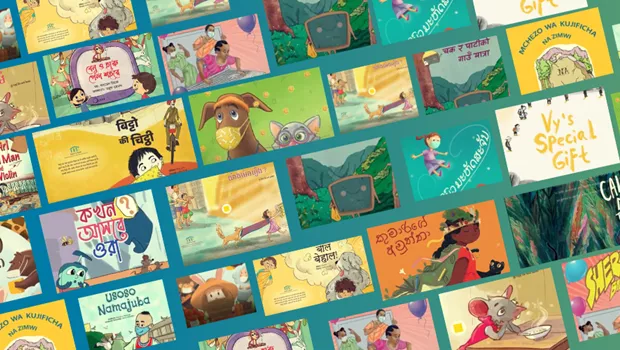Helping children cope through COVID-19: developing the skills that children need to learn
April 13, 2022
Last month, Christabel Pinto, Room to Read’s senior director, Global Literacy Program, drew on Room to Read’s storybook collection of more than 4,800 titles in 49 languages to discuss how story sharing with children can support their social and emotional development. Below, find an introduction to social-emotional learning, learn how Room to Read is integrating social-emotional learning into our Literacy Program and watch the recording of Christabel’s March 23 webinar, “SEL through literacy instruction: developing social and emotional skills while reading aloud,” to explore the many ways in which story sharing supports the development of literacy and social-emotional skills.
What is social-emotional learning?
The nonprofit Collaborative for Academic, Social, and Emotional Learning (CASEL) defines social-emotional learning (SEL) as "the process through which all young people and adults acquire and apply the knowledge, skills, and attitudes to develop healthy identities, manage emotions, achieve personal and collective goals, feel and show empathy for others, establish and maintain supportive relationships, and make responsible and caring decisions."
Social-emotional learning is focused on five core social and emotional competencies. These competencies are what CASEL describes as “broad, interrelated areas that support learning and development.” They include:
- SELF-AWARENESS: Recognizing one's emotions, values, strengths and challenges, and how they influence behavior
- SELF-MANAGEMENT: Managing emotions, thoughts and behavior, and achieving goals and aspirations, which can include the ability to persevere in the face of challenges
- SOCIAL AWARENESS: Showing understanding and empathy for others
- RESPONSIBLE DECISION MAKING: Making caring and constructive choices about personal behavior and social interactions
- RELATIONSHIP SKILLS: Establishing and maintaining healthy and supportive relationships
CASEL notes that SEL in a school or learning environment can take many forms, but “often involves a focus on building positive relationships among students and adults, dedicated time to learn social and emotional skills, and weaving in opportunities for students to practice reflection and collaboration during academic subjects.”
The need for social-emotional learning
Social-emotional learning highlights the complex ways in which a young learner’s — and all learners — emotions and social environment influence their capacity to learn and their ability to develop core competencies. Research has shown that children and adults alike learn best in secure, supportive environments, when we have healthy relationships with our peers, experience a sense of belonging and have opportunities to practice social and emotional skills. Thus, as Christabel notes in the webinar below, SEL is important in all stages of development and learning. It is also particularly important in times of crisis.

“From my Window,” a Room to Read original co-publication, written and illustrated by Huda Al Shaer, Jordan
The COVID-19 pandemic has underscored the critical and urgent need for social-emotional learning in and outside the classroom. Pandemic-related disruptions to children’s daily routines and an increase in adverse childhood experiences like illness, death and familial conflict have left many children confused and overwhelmed by challenging emotions and the lack of predictability about what might come next. And, with limited access to social supports and community buffers — the activities and practices like school and athletic events, cultural gatherings and faith-based activities that help children persevere in the face of adverse experiences — children have spent much of the pandemic in isolation.
Developing social and emotional skills helps children cope with these challenges, and in so doing, supports continued learning.

“Brave Rima,” a Room to Read publication, written by Rakibul Islam and illustrated by Shamim Ahmed, Bangladesh
“Anyone who has been a teacher knows that if a child is struggling to manage their impulses, has difficulty persevering in times of challenge or when things are boring, has trouble with their peers and peer relationships, that child is going to struggle to learn anything academic in the classroom,” she says. “You need to have strong social and emotional skills in order to learn.”
Literacy and social-emotional learning
Social-emotional learning has long been part of Room to Read’s Girls’ Education Program. Our life skills curriculum has supported girls as they chart and pursue successful life paths and change their communities and the world for the better. Through our Girls’ Education Program, we have helped girls develop critical life skills like self-confidence, perseverance, critical thinking and communication. We have also worked with them to build the knowledge they need to pursue their dreams — through lessons, activities and mentorship focused on themes like financial education as well as sexual and reproductive health, among others.
It was with the experience and knowledge gained from implementing SEL into our Girls’ Education Program curriculum that, amid the pandemic, we looked for opportunities to support SEL through our Literacy Program as well.
“We looked at our Literacy Program and asked ourselves, ‘what are some ways in which we can support children at this difficult time in their social and emotional development?” Christabel remembers. “And how can this support them in the future when we return to some kind of normalcy?’”
For the last 22 years, Room to Read’s Literacy Program has trained and coached teachers, created quality books and other learning materials and established libraries filled with diverse children’s books in local languages. Reflecting on how Room to Read might integrate SEL into the program, Christabel and our literacy team recognized two key areas that offered opportunities for development: children’s books and the practice of read alouds.

“What is Peace?” a Room to Read original publication, written by John Lasack and illustrated by Kat Yao, United States
“How can we think about SEL as we develop materials for children?” Christabel asks. “And how can the process of book and story sharing provide an opportunity to support SEL as well?”
When Room to Read’s literacy team reviewed how children develop skills in academic subjects and how they develop social and emotional skills, they discovered important parallels. First, the building of literacy skills and the development of social-emotional skills both follow a developmental progression in which children learn basic skills and build on those skills over time, adding greater complexity along the way. Moreover, both literacy and social-emotional skills are learned at home and at school in the context of supportive environments. Both literacy and social-emotional skills are learned through interaction — listening, observation and direct instruction — through practice in different contexts and through trial and error. Finally, the development of both literacy skills and social-emotional skills is enhanced by feedback and modeled behaviors.
“Recognizing these parallels made the integration of SEL into our existing program quite natural,” Christabel says. “We also realized that the added benefit of integrating SEL into our Literacy Program would be that the skills learned would be experienced as integral to learning and to life, rather than as something separate.”
SEL and the practice of reading aloud
Children’s literature is essential in building literacy in young learners. Beginning readers need engaging books that pique their interest in reading and provide them with opportunities to practice their reading skills. And, because books provide an entry point to experience difficult emotions and experiences within the safety of an imaginary world, children’s literature is also a critical tool in developing social and emotional skills.
Christabel describes stories as both mirrors and windows. Books that reflect or mirror a child’s own lived experiences help build self-awareness. Books that allow a child to explore different places and diverse characters help build social awareness. Stories also expand opportunities for children to build empathy, practice self-reflection, engage in problem-solving and adopt different perspectives — all core components of social-emotional learning.

Children engaged in a read aloud in Room to Read’s Literacy Program in Cambodia
The practice of reading aloud dialogically further supports the development of both literacy and social-emotional skills. The reader of the story models strong reading behavior and fluency for the listening child, and the conversational style of the read aloud helps young learners learn new vocabulary and supports language comprehension.
The read aloud process is also a social one. The shared experience of reading is an important interaction between the authors and illustrators, the characters, the reader and the listeners. As Christabel notes, “it involves emotional communication.” The reader brings the story to life for the child, expressing emotion through tone, pitch and cadence. This emotion captures the listener’s attention and enhances learning.
Watch Christabel Pinto’s presentation — “SEL Through Literacy Instruction: Developing Social and Emotional Skills While Reading Aloud” — via the link below to learn how SEL has been integrated into our children’s books and literacy programming.
Explore thousands of children’s books that support social and emotional learning on Literacy Cloud, Room to Read’s digital library!



